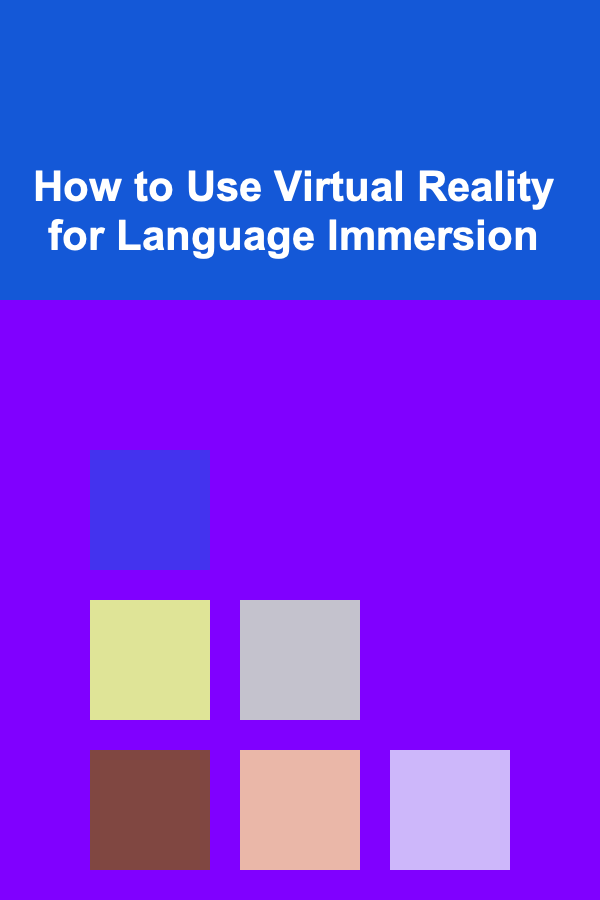
How to Use Virtual Reality for Language Immersion
ebook include PDF & Audio bundle (Micro Guide)
$12.99$11.99
Limited Time Offer! Order within the next:

Virtual Reality (VR) is revolutionizing various industries, from gaming to healthcare, education, and beyond. One of the most promising applications of VR is in language learning, where it offers immersive experiences that can simulate real-world interactions in different linguistic and cultural environments. By stepping into a virtual world, language learners can practice speaking, listening, reading, and writing in the target language, making the process more engaging, effective, and authentic. In this article, we will explore how Virtual Reality can be used for language immersion and how you can integrate it into your language learning journey.
The Concept of Language Immersion
Language immersion is a technique where learners are fully surrounded by the language they are studying, encouraging them to use it in daily life. The idea is that constant exposure to the language, combined with meaningful interaction, enhances fluency. Traditional immersion typically involves living in a country where the target language is spoken, or engaging in immersion-based educational programs. This exposure to native speakers and natural dialogues creates an environment that promotes active learning and cultural understanding.
However, not everyone has the opportunity to travel abroad or attend immersive language schools. This is where Virtual Reality steps in, offering a safe, accessible, and interactive environment for language learners to engage with their target language in a context that closely resembles real-life situations.
What is Virtual Reality?
Virtual Reality is a computer-generated simulation of a three-dimensional environment that users can interact with using special electronic equipment, such as VR headsets, gloves, or controllers. In a VR environment, the user feels as if they are physically present in a simulated world, which can range from real-world settings, like a café in Paris, to fantastical or abstract landscapes. The goal is to create an experience that is as close to reality as possible, immersing the user in the environment and providing a sense of presence.
In the context of language learning, VR allows students to practice the language within a variety of scenarios that mimic everyday life. These experiences can be interactive, offering a more engaging and realistic alternative to traditional language exercises.
Why Virtual Reality is Effective for Language Immersion
1. Realistic Context and Situational Learning
In a traditional classroom setting, language learners often practice grammar and vocabulary in isolation, without the context that makes the language meaningful. Virtual Reality immerses learners in real-world situations, allowing them to practice their language skills in context. Whether ordering food at a restaurant, participating in a job interview, or navigating a foreign city, VR offers situational learning that connects language with real-world applications.
For instance, learners can visit a virtual market in a Spanish-speaking country and practice purchasing items while interacting with virtual vendors who respond in Spanish. These experiences mimic real-life situations, making language learning more applicable, practical, and useful.
2. Interactive and Engaging Experiences
Traditional language learning methods often rely on passive activities such as memorization and textbook exercises. VR transforms this passive learning into active participation. The immersive nature of VR requires users to engage with their surroundings, interact with objects, and communicate with virtual characters. This active participation enhances learning retention and fosters a deeper connection with the language.
VR language learning platforms often include interactive tasks such as speaking to virtual characters, solving puzzles, and participating in conversations that adapt based on the user's responses. This interactivity promotes more natural language acquisition, as learners use the language for practical communication rather than abstract learning.
3. Overcoming Fear and Anxiety
Many language learners struggle with speaking the language due to fear of making mistakes or being judged by others. VR provides a safe environment where learners can practice speaking without the pressure of interacting with real people. Virtual characters do not judge, and learners can practice conversations as many times as necessary without feeling self-conscious. This builds confidence and encourages learners to take risks in their language use, which is crucial for improving fluency.
Additionally, VR can simulate different social contexts, such as casual conversations with friends or formal interactions with authority figures, helping learners navigate a variety of social situations in the target language.
4. Cultural Exposure
Language is inseparable from culture, and true fluency requires an understanding of the cultural context in which the language is spoken. VR provides an opportunity to immerse yourself not only in the language but also in the cultural nuances that influence its use. Learners can virtually visit different countries, attend cultural festivals, or interact with native speakers to gain a deeper appreciation of cultural practices, customs, and behaviors.
For example, VR programs can simulate visiting a French café, where learners practice ordering food while observing local etiquette. Such experiences offer an authentic sense of place and help learners understand the cultural backdrop of the language.
5. Personalized Learning Experience
One of the most significant advantages of VR is its ability to tailor the learning experience to individual needs. VR language learning programs often adapt to the learner's progress, offering customized lessons that align with their proficiency level and learning goals. If a learner struggles with pronunciation, the system can offer additional speaking exercises or correct errors in real time. This personalized feedback ensures that learners progress at their own pace and focus on areas where they need the most improvement.
Additionally, VR can offer various difficulty levels, allowing learners to start with basic vocabulary and gradually progress to more complex conversations. This adaptability makes VR language immersion accessible to learners of all levels, from beginners to advanced speakers.
How to Use Virtual Reality for Language Immersion
1. Choose the Right VR Language Learning Platform
There are several VR platforms available for language learning, and choosing the right one depends on your goals, language proficiency, and interests. Some popular VR language learning platforms include:
- Mondly VR: This platform provides interactive lessons where learners can practice speaking with virtual characters in real-life situations, such as ordering food at a restaurant or traveling through a foreign city. Mondly VR offers a wide variety of languages, including Spanish, French, German, and more.
- ImmerseMe: This immersive platform offers a variety of scenarios, such as shopping, dining, and socializing, where learners can practice real-life conversations. It provides immediate feedback and tracks your progress as you move through different levels.
- ClassVR: While primarily used in educational settings, ClassVR provides an immersive environment where learners can interact with both the language and the culture. It offers a variety of content that can be tailored to the learner's level.
When selecting a VR language learning platform, ensure it aligns with your learning preferences, such as whether it offers a combination of speaking, listening, and interactive tasks, and if it has a wide selection of scenarios relevant to your learning goals.
2. Set Clear Learning Goals
Before you begin your VR language immersion experience, it's important to set clear and achievable language learning goals. For instance, if you are learning French, you might set a goal to improve your conversational skills by practicing basic phrases or expanding your vocabulary related to food and dining.
Your goals should be specific, measurable, and realistic. For example:
- "I want to be able to order food in a French restaurant using proper vocabulary and polite phrases."
- "I want to hold a 5-minute conversation in Spanish with a virtual character about my daily routine."
Setting clear goals helps you stay focused, track your progress, and ensure you're practicing the language in a meaningful way.
3. Practice Regularly and Consistently
To maximize the benefits of VR language immersion, it's essential to practice regularly. Just like traditional language learning, consistency is key. Schedule time each week to practice using VR, whether it's for 20 minutes or an hour, and commit to using the language actively during your sessions. The more frequently you practice, the more likely you are to retain vocabulary, improve your pronunciation, and develop conversational fluency.
Consistency also means revisiting previously learned scenarios and lessons to reinforce what you've learned and ensure it sticks. VR programs often offer repetitive exercises to help reinforce learning, but it's important to continue practicing beyond the VR experience as well.
4. Combine VR with Other Language Learning Tools
While VR is an excellent tool for immersion, it works best when combined with other language learning resources. For example, use VR in conjunction with traditional methods such as textbooks, language apps, and podcasts to reinforce vocabulary, grammar, and listening skills.
Additionally, try to engage in real-world interactions with native speakers through language exchange programs, social media, or travel. This will help you move beyond virtual practice and build confidence in applying the language in real-life contexts.
5. Embrace the Learning Process
Language learning through VR immersion is a dynamic and exciting process, but it may come with challenges. Embrace the journey, stay patient, and celebrate small milestones. VR allows for repetition and practice, so don't be afraid to make mistakes. The more you practice, the more natural and comfortable the language will become.
Remember that language immersion, whether virtual or real, is not just about mastering vocabulary and grammar. It's about developing a deeper connection to the language, its speakers, and its culture.
Conclusion
Virtual Reality is a powerful tool for language immersion, offering learners an immersive, interactive, and culturally rich environment to practice their target language. By combining VR with regular practice, goal-setting, and a variety of language learning resources, you can significantly enhance your language proficiency and cultural understanding. Whether you're a beginner or an advanced learner, VR provides an engaging and effective way to immerse yourself in a new language and take your language skills to the next level.
As technology continues to evolve, the possibilities for using VR in language learning will only expand, making it an increasingly accessible and valuable tool for learners around the world. So, grab your headset, dive into a new virtual world, and start your immersive language learning journey today!
Reading More From Our Other Websites
- [Home Storage Solution 101] How to Maximize Small Room Space: Saving Ideas for Better Living
- [Organization Tip 101] How to Conduct a Thorough Inventory Assessment
- [Personal Investment 101] How to Use Pre-Trained Models to Make Money
- [Home Staging 101] How to Stage a Home with a Limited Budget
- [Personal Financial Planning 101] How to Achieve Financial Goals by Setting SMART Objectives
- [Home Lighting 101] How to Install Semi-Flush Mount Lights for a Modern Look
- [Whitewater Rafting Tip 101] From Rapids to Results: The Ultimate Rafting Workout for Full-Body Conditioning
- [Home Rental Property 101] How to Avoid Common Mistakes Landlords Make with Rental Properties
- [Organization Tip 101] How to Choose the Right Self-Leveling Underlayment for Your Floor
- [Organization Tip 101] How to Create a Seasonal Centerpiece That's Easy to Change

How To Master Influencer Marketing for Small Businesses
Read More
How to Renovate Your Home for Resale Value
Read More
How to Use Drawer Organizers to Simplify Your Home Storage
Read More
How to Use Webinars to Teach Advanced Dropshipping Strategies
Read More
Top Thrifty Baby and Toddler Essentials Every Parent Should Know About
Read More
Understanding Your Paycheck: A Comprehensive Guide
Read MoreOther Products

How To Master Influencer Marketing for Small Businesses
Read More
How to Renovate Your Home for Resale Value
Read More
How to Use Drawer Organizers to Simplify Your Home Storage
Read More
How to Use Webinars to Teach Advanced Dropshipping Strategies
Read More
Top Thrifty Baby and Toddler Essentials Every Parent Should Know About
Read More